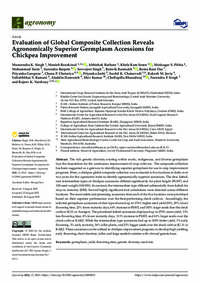Evaluation of Global Composite Collection Reveals Agronomically Superior Germplasm Accessions for Chickpea Improvement

Authors:
The rich genetic diversity existing within exotic, indigenous, and diverse germplasm lays the foundation for the continuous improvement of crop cultivars. The composite collection has been suggested as a gateway to identifying superior germplasm for use in crop improvement programs. Here, a chickpea global composite collection was evaluated at five locations in India over two years for five agronomic traits to identify agronomically superior accessions. The desi, kabuli, and intermediate types of chickpea accessions differed significantly for plant height (PLHT) and 100-seed weight (100 SW). In contrast, the intermediate type differed substantially from kabuli for days to maturity (DM). Several highly significant trait correlations were detected across different locations. The most stable and promising accessions from each of the five locations were prioritised based on their superior performance over the best-performing check cultivar. Accordingly, the selected germplasm accessions of desi type showed up to 176% higher seed yield (SY), 29% lower flowering time, 21% fewer maturity days, 64% increase in PLHT, and 183% larger seeds than the check cultivar JG11 or Annigeri. The prioritised kabuli accessions displayed up to 270% more yield, 13% less flowering time, 8% fewer maturity days, 111% increase in PLHT, and 41% larger seeds over the check cultivar KAK2. While the intermediate type accessions had up to 169% better yield, 1% early flowering, 3% early maturity, 54% taller plants, and 25% bigger seeds over the check cultivar JG 11 or KAK2. These accessions can be utilised in chickpea improvement programs to develop high-yielding, early flowering, short duration, taller, and large-seeded varieties with a broad genetic base.
